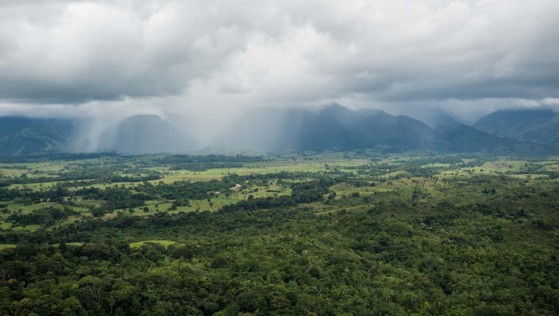Colombia steps up the battle against Amazon deforestation
Historical archive
Published under: Solberg's Government
Publisher: Ministry of Climate and Environment
News story | Date: 19/09/2017
Colombian authorities are stepping up their efforts to preserve the country's valuable rainforests. Air Force planes that used to drop bombs on the FARC guerillas are now instead dropping flyers telling people not to burn or chop down trees.
Colombia's president Juan Manuel Santos informed Norwegian Minister of Climate and Environment, Vidar Helgesen, about the country's new actions against deforestation when they met during the UN General Assembly in New York.
Colombia is experiencing increased deforestation in areas that were earlier controlled by the FARC-guerilla.
- Colombia has taken many forceful steps to preserve its rainforests. But the increased deforestation last year is worrying, says Minister Helgesen.
He welcomes the new efforts of the Santos government to slow down deforestation in areas of the Amazone where armed conflict used to rage between FARC and government forces.

Special units
Colombia is stepping up its efforts against illegal logging in several areas.
Special units including armed forces, police, prosecutors and environmental authorities are established in the areas most vulnerable to deforestation. The plan is to establish the same kind of units in every region of the country.
Air force planes are being used for surveillance and to collect information about deforestation hot spots. Instead of bombs, the planes drop flyers about the importance of stopping deforestation.
Removing illegal Amazon roads
Colombian authorities have already destroyed several illegal roads and airstrips in the Amazon. Three main roads constructed during the years of civil war will be removed.
The illegal roads pose a real threat to the Amazon because they open the forests to illegal loggers and the establishing of coca farms. The roads can also be used to establish unwanted settlements in protected areas.
- Unplanned, unregulated road construction can become disastrous to the rainforest. The fact that the authorities now try to stop this may prevent the loss of Colombia's unique nature for the benefit of future generations, says Minister Helgesen after his talks with President Santos.
Supporting new ways of income
President Santos will also establish a national commission to control and protect the rainforests.
-In this process it will be crucial to offer local settlers new ways of income. Norway supports these efforts among other things through our contribution to the Colombia Sostenible fund, says Vidar Helgesen.
Norways first contribution of USD 10 million to the fund was given during his visit to Colombia in june.
Norway's rainforest partnership with Colombia
Rainforests and climate emissions
- Colombia's rainforests cover more than 600.000 square kilometers
- Most of the forest are within the Amazon basin
- About 50% of Colombia's climate emissions come from deforestation and agriculture
- Colombia is one of the main partner countries in Norway's International Climate and Forest Initiative.
The partnership from Paris 2015
- Colombia, Norway, Germany and The United Kingdom established a climate- and forest partnership during the UN Climate Change Conference – COP21 – in Paris 2015.
- Norway has promised to pay Colombia a maximum of NOK 1,8 billion before 2020.
- A mimimum of NOK 1,5 billion will only be paid for verified emission reductions
- Most of the money will be paid to the Colombia Sostenible fund
- The aim is to contribute to a peaceful, sustainable development of Colombia's rural areas, reduce powerty in the areas hit hardest by the conflict and to reduce national deforestation.
Reasons for increased deforestation
- The deforestation rate in the Colombian Amazon has been reduced several years in a row.
- However, from 2015 to 2016 deforestation increased from 1240 square km to 1790 sqkm, according to the latest report published by the Colombian Meteorological Institute and Environmental studies (IDEAM)
- The deforestation rate is still lower than the average level the last 20 years.
-
According to Colombian authorities the main reasons for the increased deforestation are illegally occupied landareas, increased production of coca, increased beef production, road construction, illegal mining and forest fires.
- Illegal coca production and mining is the main source of income for many of the actors trying to gain control over areas formerly military controlled by FARC